Healing as a complement to traditional medical therapy for patients with lung cancer.
B Hammarstrom, L Rindstam, H Riska, C Lindholm
A pilot study involving “healing” for patients with lung cancer was conducted at the Uppsala University Hospital in Sweden. Four patients in the experimental group received “healing” once a week in combination with the traditional medical treatment with chemotherapy. Five patients served as a control group receiving only traditional medical treatment. Healing was administered through a form of spiritual healing (Hodges p. 205). The specific method used was the Swedish Rindstam method involving the activation of spinal energy centres combined with acupressure. The influence of healing on peripheral circulation was analysed with infrared technique measuring the temperature of the skin, which showed a significant increase after healing. The patient’s subjective experience of increased warmth and heat radiating through the body corresponded to results with the infrared heat camera. The study on quality of life shows tendencies to differences between the two groups. Patients in the group receiving healing had, in all situations, felt better at the completion of chemotherapy than had patients in the control group. It is difficult to draw any general conclusions from this material, however, no negative effects of healing were recorded during this study.
Background
The Swedish committee for Alternative medicine stated in an official report to the Ministry of health and social affairs (SOU 1989:60) that research in alternative and complementary therapies is important. This investigation revealed that 20 percent of the Swedish population choose alternative forms of treatment when they were ill. Healing is one of these alternative treatment forms. The word healing comes from the German word heil, which means whole. Healing is considered to be a process whereby the body uses its own healing recourses to return to a state of wholeness: in emotions, psyche and soul. Healing can be described as:
The direct interaction between one individual, the healer, and a second, sick individual with the intention of bringing about an improvement or cure of the illness. Any healing effect results from the channelling of an, as yet unrecognised, energy through the healer to the patient. (Hodges, R.D. & Scofield, A.M. 1995, s 203.)
Healing as a complement to traditional medical therapy is seldom practised in Sweden. In England the General Medical Council has amended its ethical rulebook so that doctors can recommend patients to healers. Even the Department of Health has changed its administrative rules to allow general practitioners to employ these practitioners in their practices. There are 8000 registered healers in England who practice both within and outside of the National Health Service. Research on alternative medicine is ongoing in England and the United States (Bendor, D.J, 1993. Hodges, R.D. & Scofield, A.M, 1995.) There is, to our knowledge, no comparative research on alternative and complementary therapies in Sweden.
The purpose of this pilot study is to study and compare medical effects and quality of life for patients who receive healing as a complement to medical treatment with patients who receive only medical treatment.
Research questions:
• Can a tendency be shown that healing
has an effect on the teperature of the
skin?
• Can differences in quality of life
parameters be shown for patients
receiving healing compared with those
who do not receive healing?
• What are patient’s subjective
experiences of healing?
Subjects
Nine patients with diagnosed lung cancer were at the time of this study scheduled for chemotherapy at the outpatient clinic at the University hospital in Uppsala. All of the patients agreed to participate in the study. The deciding factors for participation in the healing group were the patients personal wishes, the distance between the patients home and the hospital and that the onset of healing therapy should coincide as close as possible with onset of chemotherapy.
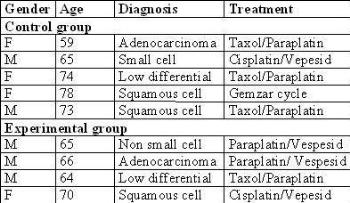
Method
Five patients, two men and three women, were in the control group and received only chemotherapy. Four patients, three men and one woman received healing once a week in addition to chemotherapy.
The patients receiving healing did not pay extra for healing treatment.
The healing therapy was administered in the form of laying-on-of-hands for a period of 30 minutes.
Two of the patients in the healing group were photographed on four occasions with an infrared camera, Thermovision 550, (borrowed from Agema, Infrared Systems AB) before healing and 30 minutes after healing treatment. The pictures were processed and analysed by Agema.
All of the patients were asked to answer a quality of life questionnaire, EORTC-QLQ-C30, on three occasions, before, during and one to two weeks after completion of healing treatment.
The patients receiving healing reported their state of health during the periods between healing sessions.
Blood circulation
Patients in the healing group experienced a feeling of heat radiating throughout their bodies during the healing treatment. No patients in the control group reported symptoms of increased body warmth. To establish a correlation between the patient’s subjective experience of warmth and actual skin temperature, infrared pictures of the back were taken before treatment and 30 minutes after completion of the healing.
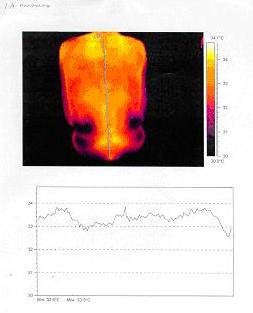
Fig.1
Picture taken before healing treatment.
Temp: Min. 32.6º C Max 33.9º C
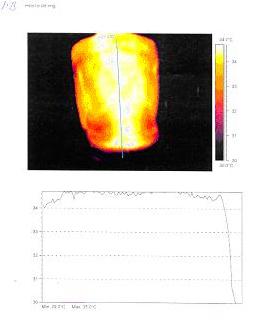
Fig.2
Picture taken 30 minutes after treatment.
Temp: Min. 34º C Max 35º C
The infrared pictures show minimal and maximum registered skin temperatures.
The results showed an increase in the lowest measured skin temperature of 1.4 degrees centigrade and an increase of the highest measured temperature of 1.1 degrees centigrade.
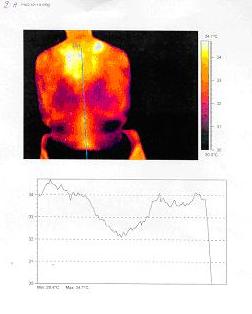
Fig.3
Picture taken before healing treatment.
Temp: Min. 32.2º C. Max. 34.7º C
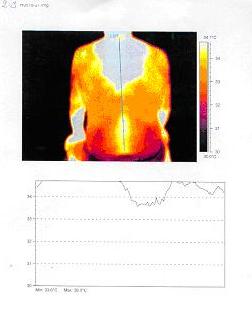
Fig.4
Picture taken 30 minutes after treatment.
Temp. Min. 33.6º C. Max. 36.0º C
The results showed an increase in the lowest measured skin temperature of 1.4 degrees centigrade and an increase of the highest measured temperature of 1.3 degrees centigrade.
Quality of life
EORTC QLQ-C30 is an instrument used in cancer research to measure quality of life. All of the patients were asked to answer the questionnaire on three occasions: before onset of treatment, 6 weeks after onset of therapy and after completion of treatment. Chemotherapy was initiated before onset of healing therapy for three of the four patients in the healing group. Four patients from the control group and three from the healing group completed all three questionnaires.
Symptoms such as fatigue, pain, dyspnea, nausea and vomiting, sleep disturbances, appetite loss, constipation and diarrhoea as well as experiences of financial difficulties are common for patients with cancer. In addition, chemotherapy is associated with side affects such as nausea and vomiting, appetite loss, constipation and/or diarrhoea. Symptom occurrence was compared between the two groups.
Levels of functioning
Levels of functioning before treatment were similar. The patients in the control group reported higher levels than the intervention group in cognitive, social and physical functioning whereas during treatment they reported higher scores only in cognitive functioning. After treatment, the patients receiving healing registered higher values than the control group on all of the functional scales with the greatest differences in physical functioning and roll functioning. Patients in the control group registered decreased levels of functioning in physical, emotional, cognitive and social functioning and were at the same level as before treatment in role functioning.
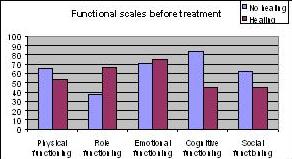
Fig. 5
Functional scales before onset of healing
therapy.
A higher score represents a higher level
of functioning. n=7
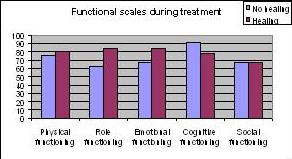
Fig. 6
Functional scales 6 weeks after onset of
treatment. n=7
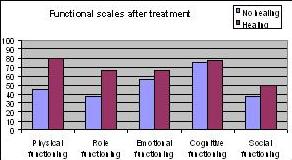
Fig. 7
Functional scales after completion of
chemotherapy. n=7
Global health status
Patients in the group receiving healing registered increasingly higher scores in quality of life compared to their situation before onset of healing treatment. Patients in the control group registered scores reflecting poorer quality of life after treatment with chemotherapy than before.
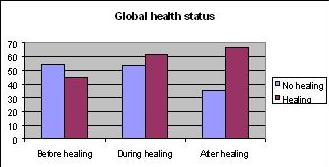
Fig. 8 Global health status.
A higher score represents a higher quality of life.
n=7
Presence of symptoms
Before treatment, patients in the experimental group reported a higher frequency of symptoms. At completion of treatment, patients receiving healing reported fewer symptoms. Patients receiving healing reported no presence of nausea and vomiting, very little pain, no sleep disturbance, no appetite loss, no constipation, and no diarrhoea.
Lower scores represent fewer symptoms.
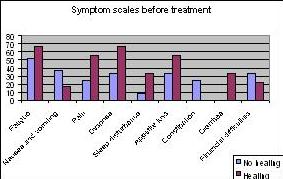
Fig. 9
Symptoms before onset of healing therapy.
(Absence of staple = no symptoms) n=7
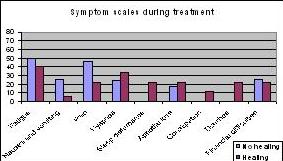
Fig.10
Reported symptoms 6 weeks after onset of
healing therapy. n=7
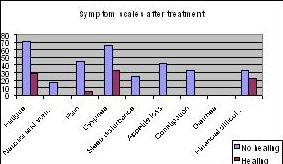
Fig.11
Reported symptoms 1 to 2 weeks after
completion of chemotherapy. n=7
Subjective experience of healing
All of the patients experienced heat radiating through their body during healing treatment. They were very relaxed and one patient went into a deep state of relaxation with sensations of weightlessness. Another patient experienced “warmth that radiated from the inside and out” and a feeling of wellbeing. A third patient felt a strong sensation of heat, which radiated down to his feet during treatment. All of the patients receiving healing noticed that their urine became darker and smelled stronger after the first healing treatments even though they had to urinate oftener and the amount of urine increased. They were encouraged to drink more fluids after every treatment. All of the patients experienced a permanent state of increased body warmth. One of the patients had cold feet and experienced an uncomfortable feeling of needles under his feet, “my feet didn’t feel like part of my body”, before he started healing therapy. After three treatments he stopped wearing thick socks and regained normal sensations in his feet. Another patient felt much more fit with less dizziness and more energy. At the beginning of therapy he was dependent on his wife for support when walking and after eight weeks he was playing 9-holes of golf. Three of the patients, who were sleeping poorly before healing therapy, began sleeping better after therapy started. Another patient who was having difficulty drinking and eating regained her normal appetite after the onset of healing therapy despite ongoing chemotherapy treatment.
Discussion
Analysis of the influence of healing on peripheral circulation showed that the temperature of the skin increased after healing treatment. The patient’s subjective experience of increased warmth and heat radiating through the body corresponded with results from the infrared camera study. No patients in the control group reported symptoms of increased body warmth. The study on quality of life parameters showed tendencies to differences between the two groups. Patients in the group receiving healing felt, in all situations, better at the completion of chemotherapy than did patients in the control group. The groups were small and individual differences have a strong influence on the results. Future studies with larger groups are needed for more conclusive results.
The patients in the healing group reported that their urine was darker and more abundant after treatment. An explanation for this could possibly be that the body rinses out waste products and that blood circulation to the renal system increases. It could be worthwhile to examine the contents of urine in a future study and compare the results with a control group.
It is difficult to draw any general conclusions from this material. To establish grounds for reliability, a larger, more comprehensive study is necessary. In this study we did not record any negative effects of healing.
1. SOU 1989:60, Ministry of health and social
affairs. Stockholm.
2. Benor, D.J., Healing Research: Holistic Energy
Medicine and Sprituality, Vol 1, Research in
Healing.
Deddington, Oxon: Healing Edition Ltd, 1993.
3. Hodges, R.D. & Scofield, A.M., Is spiritual healing
a valid and effective therapy?
Journal of The Royal Society of Medicine
Vol. 88, 1995.
4. Krieger, D., Therapeutic touch: The imprimatur of
nursing. American Journal of Nursing, 1975.
5. Wetzel, W., Reiki healing: a physiologic
perspective, Journal of Holistic Nursing, 1989.